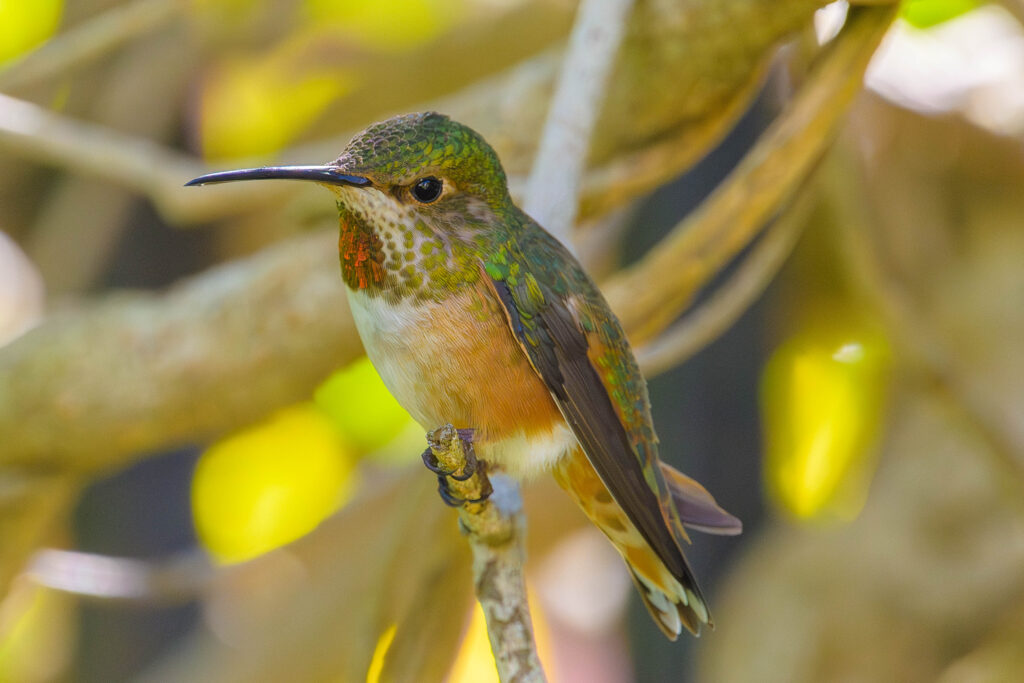Why Do Hummingbirds Chirp? Here are 4 Common Reasons

Hummingbirds are only slightly larger than a nickel, yet they can be surprisingly noisy when feeding, flying, or interacting with one another.
Interestingly, each species of hummingbird has its own distinct chirps and vocalizations, though it can still be tricky to tell them apart.
So, why do hummingbirds chirp—and when are you most likely to hear their lively chatter? Let’s explore those questions and more below!
Why Do Hummingbirds Like to Chirp?
Hummingbirds, often called hummers, belong to the Trochilidae family. Unlike many other birds, they have relatively weak vocal cords.
Even so, some species are still classified as songbirds. Their name comes from the distinctive humming sound produced by their rapidly beating wings—the vibration of their primary feathers creates this unique noise in flight.
While hummers may not rely on their voices as much as other birds, they still enjoy chirping and chattering with one another—and they do so for a variety of reasons.
1 – A Sign of Satisfaction
To start, if you notice a hummingbird chirping near flowers, it’s often a sign that it’s happily sipping nectar. The sound can be compared to a person softly humming while enjoying a favorite meal.
Sometimes, the chirping grows louder as the bird gets more excited about its food. In other cases, it may suggest the hummingbird has spotted something interesting during its feeding and simply can’t resist chattering about it.
2 – Fear of a Threat
Hummingbirds often use chirping to warn others that a particular spot is their territory. These tiny birds can be surprisingly territorial and may become aggressive when it comes to protecting food and water sources.
For males, one of the first lines of defense is sound. A sharp, persistent chirp serves as a warning meant to drive away intruders. That said, not all species are equally confrontational—some are far less aggressive and may avoid using vocal threats altogether.
3 – A Mating Call
Chirping also plays an important role in hummingbird courtship. Males often add chirps to their dramatic dance or dive displays to boost their chances of attracting a mate.
Females, meanwhile, may use chirps to signal their readiness to nest and raise young. Although they tend to be less vocal than males, females still use chirping as part of the same courtship communication.
4 – Kind Greetings
In more friendly situations, a hummingbird—male or female—may chirp as a way of greeting another hummer, or even a human it recognizes. They might also let out soft chirps at unfamiliar objects as a sign of curiosity.
Whatever the reason, a hummingbird’s gentle chatter is usually a sign of contentment and good health. What they lack in size and vocal power, they make up for with their cheerful chirping.
How to Know Why a Hummingbird Is Chirping
Since hummingbirds chirp for many different reasons, it can be tricky to pinpoint exactly what’s behind the sound.
Birdwatchers, however, often rely on a simple guideline: pay attention to the intensity and pitch of the chirp. These two qualities usually offer clues about the bird’s purpose.
For instance, a hummingbird defending its territory will chirp more aggressively, often in a sharp, high-pitched tone. This sound can sometimes be mistaken for the calls of young hummingbirds, which also cry loudly in their nests to demand food and attention from their mothers.
By contrast, chirps made during feeding or courtship tend to be softer and shorter. In these moments, there’s no need for a hummer to get overly vocal—whether it’s sharing space with a parent, offspring, or a potential mate.
How Do Hummingbirds Chirp?
Within the Trochilidae family, hummingbirds are unique in having vocal learning centers in their brains—specialized systems similar to those found in songbirds and parrots, allowing them to produce a variety of sounds.
In other words, these tiny birds are surprisingly smart. And their sounds aren’t limited to vocal cords alone. Hummingbirds can also use their wings and tail feathers to create chirp-like noises.
So how exactly do they manage this fascinating trick? Let’s break it down in detail below.
Their Tails
Certain hummingbird species are known as tail-chirpers—including the Ruby-throated, Black-chinned, Anna’s, Costa’s, Allen’s, Woodstar, Cuban Bee, and Rufous hummingbirds.
Instead of relying on their throats, these birds rapidly open and close their tail feathers—often in less than 60 milliseconds—to produce a sharp chirping sound. The effect is similar to the vibration of a reed in a wind instrument, like a flute or clarinet.
Males use this technique more frequently than females, especially during courtship displays. Tail chirping serves a dual purpose: attracting the attention of potential mates while also warning away rival males.
Their Wings
Hummingbirds are set apart from other birds by their remarkable wing anatomy. Thanks to their tiny, lightweight bodies, they can beat their wings at incredibly high speeds—allowing them to hover in place and even fly backward.
When at rest in the air, their wings produce the signature hum that gave them their name. But depending on how fast they’re flying, those same wings can also generate buzzes, trills, or sharp zipping sounds.
In simple terms, you can often tell what a hummingbird is doing by listening to the pitch and tone of its wingbeats. In fact, hummers sometimes use these sounds almost like a language, “conversing” with one another through their wings.
Their Vocal Cords
Only a handful of hummingbird species actually use their vocal cords to sing. While they aren’t classified as true songbirds, that doesn’t stop hummers from being plenty noisy. Almost all of them enjoy chirping and chattering with others of their kind.
Each species has its own distinct vocal style, which may include whistles, twitters, and chirps. The strength, tone, length, and quality of these songs vary widely from one hummingbird to another.
For instance, the Calliope Hummingbird has an impressive pitch range, shifting from high to low notes in just seconds. Meanwhile, the Anna’s Hummingbird is unique in its ability to sustain a single note for over ten seconds—something no other hummer can do.
Final Thoughts
This article explored the many reasons why hummingbirds chirp.
In short, a hummer may chirp while feeding to express excitement, during courtship to attract a mate, or as a warning to defend its territory. Sometimes, a chirp can even serve as a friendly greeting to another bird.
Learning when and why hummingbirds chirp offers a fascinating glimpse into their behavior—and if you’re lucky, trying to mimic their sound might even earn you a chirp in return!
